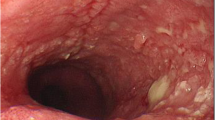Abstract
An aberrant right subclavian artery (ARSA) is an anatomical abnormality that occurs at a frequency of 0.4–2 %. It is important to be aware of this abnormality when performing radical esophagectomy for esophageal cancer because many patients with an ARSA have a right nonrecurrent inferior laryngeal nerve (NRILN) and right thoracic duct. We report three cases of esophageal cancer with ARSA treated by thoracoscopic esophagectomy. Case 1 was a 59-year-old woman with a relapse of a thoracic esophageal cancer after definitive chemoradiotherapy (CRT). Case 2 was a 76-year-old man with upper thoracic esophageal cancer who had received no treatment before the surgery. Case 3 was a 69-year-old man with upper thoracic esophageal cancer pretreated with neoadjuvant CRT. It was possible to predict an ARSA by computed tomography and the right thoracic ducts by magnetic resonance imaging before surgery in all three cases. Thoracoscopic esophagectomy with two-field lymph node dissection was performed, and the NRILN and the right thoracic duct were detected and preserved in all three cases. Because of ARSA, the operative field is limited around the left recurrent nerve, so a careful procedure is needed to avoid nerve palsy.





Similar content being viewed by others
References
Pramesh CS, Saklani AP, Parmar V, et al. Aberrant subclavian artery causing difficulty in transhiatal esophageal dissection. Dis Esophagus. 2006;16(2):173–6.
Saito T, Yamatsuki Y, Hitosugi T, et al. Three cases of retroesophageal right subclavian artery. J Nippon Med Sch. 2005;72(6):375–82.
Akihito W, Shinichi K, Hirofumi O, et al. Preoperative computed tomography diagnosis of non-recurrent inferior laryngeal nerve. Laryngoscope. 2001;111(10):1756–9.
Antonio T, Renzo M, Piotto A, et al. Identification of the nonrecurrent laryngeal nerve during thyroid surgery: 20-year experience. World J Surg. 2004;28(7):659–61.
Yamasaki M, Doki Y, Miyata H, et al. Four cases of esophageal cancer with nonrecurrent inferior laryngeal nerve: anatomical variant and intraoperative precaution. Jpn J Gastroenterol Surg. 2007;40:1466–72 (in Japanese).
Fujita H, Kakegawa T, Yamana H, et al. Mortality and morbidity rates, postoperative course, quality of life, and prognosis after extended radical lymphadenectomy for esophageal cancer. Comparison of three-field lymphadenectomy with two-field lymphadenectomy. Ann Surg. 1995;222(5):654–62.
Sato H, Tsubosa Y, Ugumori T. Esophagectomy with three-field lymph node dissection for esophageal carcinoma with a nonrecurrent inferior laryngeal nerve. Jpn J Thorac Cardiovasc Surg. 2005;53(9):502–4.
Conflict of interest
We have no conflict of interest.
Author information
Authors and Affiliations
Corresponding author
Rights and permissions
About this article
Cite this article
Teshima, J., Miyata, G., Kamei, T. et al. Three cases of esophageal cancer with aberrant right subclavian artery treated by thoracoscopic esophagectomy. Esophagus 10, 165–169 (2013). https://doi.org/10.1007/s10388-013-0363-y
Received:
Accepted:
Published:
Issue Date:
DOI: https://doi.org/10.1007/s10388-013-0363-y




